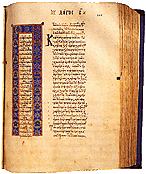| . |
||||||||
|
|
General Introduction
The Byzatines were familiar with classical texts and studied them in order to revive classical civilization. They cultivated the sciences and literature in a rational and
These activities co-existed with manifestations that were not rational at all: the metaphysical prejudices of daily life and the equally flourishing cultivation of the traditional theological thinking. The way in which these tendencies co-existed was very interesting: some times they co-existed in peace, other times in conflict and contention (such as the controversy of Hesychasm or of the union of the Churches) and other times they ended up producing new ideas and combinations found in the intellectual people of that era. In all three cases, these people with their personalities gave to the intellectual movement of their time its special style and characteristics.
 over the world. over the world.
In many cases,
In the case of some manuscripts, the date is not mentioned. Then their dating is estimated either through linking the name of the author to a historical person of that era, known from other
These texts, in combination with the information that we get from later writers on the same period of time (based perhaps on testimonies which have not survived to date) help us to recreate the picture of the intellectual movement in the Byzantium during the 13th, 14th and 15th century. |
||||||||||||||||||||||||||||||